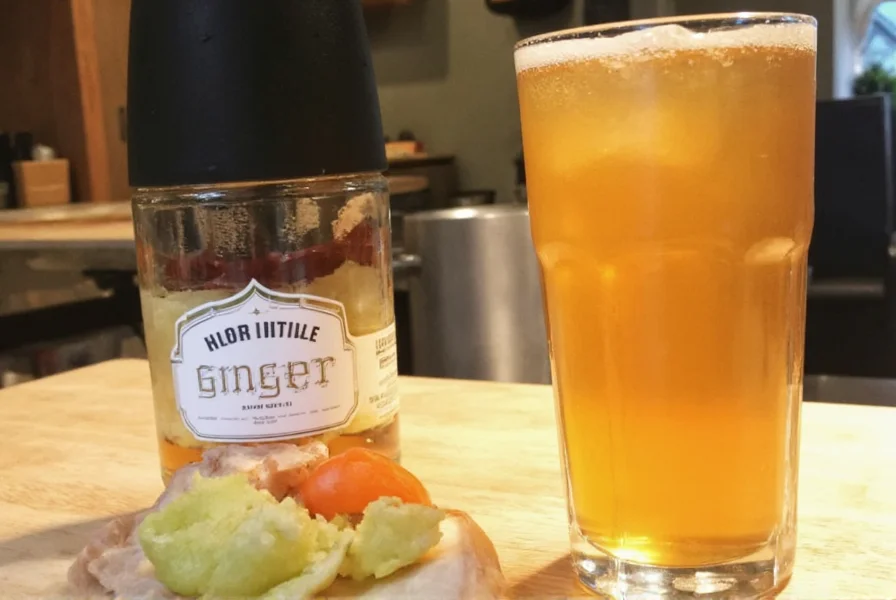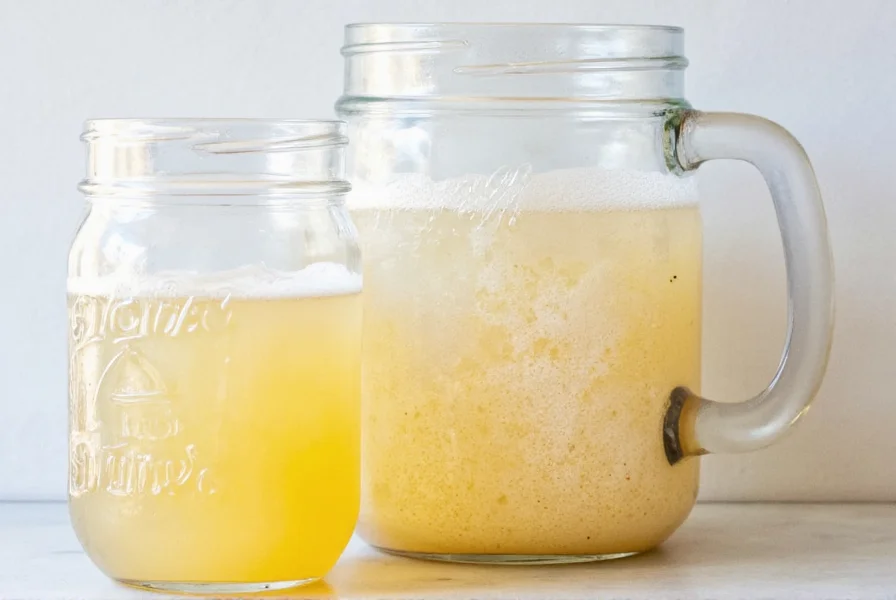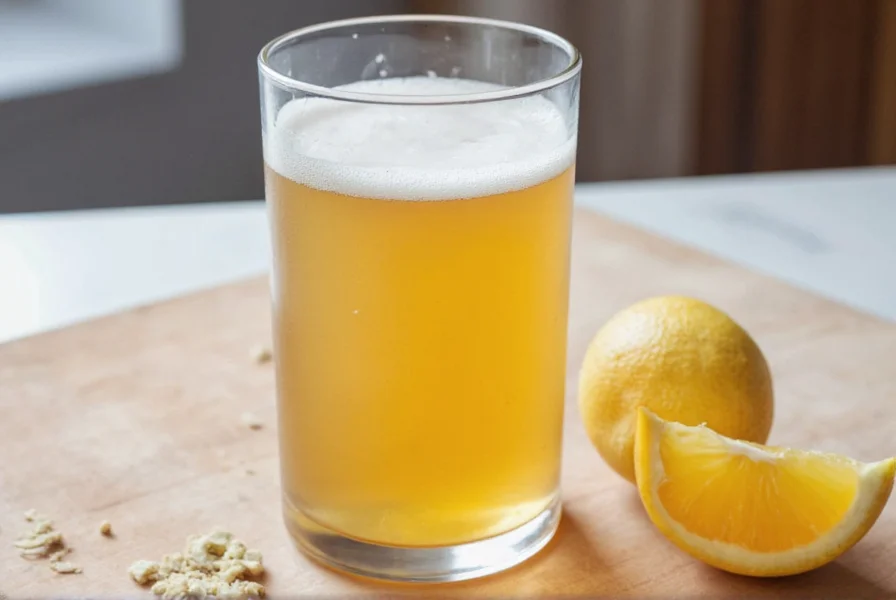The best homemade ginger beer recipe requires fresh ginger root, sugar, lemon, yeast, and water. After preparing a ginger syrup and fermenting for 3-5 days, you'll have a naturally carbonated, refreshing beverage with a spicy kick. This traditional method yields authentic ginger beer with no artificial flavors, taking about 20 minutes of active preparation plus fermentation time.
Why Make Your Own Ginger Beer?
Commercial ginger beers often contain artificial flavors and excessive sugar. Crafting your own allows complete control over ingredients and spiciness level. Homemade ginger beer delivers a vibrant, complex flavor profile with the perfect balance of heat from fresh ginger and natural sweetness. The fermentation process creates delightful carbonation while preserving beneficial enzymes.
Essential Ingredients for Authentic Ginger Beer
Quality ingredients make the difference between ordinary and exceptional ginger beer. Here's what you'll need for a 1-gallon batch:
| Ingredient | Amount | Notes |
|---|---|---|
| Fresh ginger root | 1 cup, grated | Peel with spoon for minimal waste |
| Granulated sugar | 1½ cups | Organic cane sugar preferred |
| Lemon | 1, juiced | Freshly squeezed only |
| Water | 1 gallon, filtered | Non-chlorinated for best fermentation |
| Ginger beer plant or yeast | 2 tbsp or ¼ tsp | See fermentation section for details |

Equipment Checklist
Having the right tools ensures success with your ginger beer fermentation:
- Large stockpot (4-quart minimum)
- Fine mesh strainer or cheesecloth
- Long-handled spoon (non-reactive material)
- Gallon-sized glass jug with airlock
- Plastic or glass bottles for bottling (swing-top preferred)
- Thermometer (optional but helpful)
Step-by-Step Ginger Beer Preparation
Creating the Ginger Syrup
- Peel and finely grate 1 cup of fresh ginger using a microplane
- Combine grated ginger, 1½ cups sugar, and 2 cups water in a stockpot
- Bring to a gentle simmer, stirring until sugar dissolves completely
- Remove from heat and let steep for 20 minutes
- Strain through cheesecloth, pressing to extract all liquid
- Add lemon juice to the strained liquid
Fermentation Process Explained
Proper fermentation creates the signature carbonation and complex flavor. You have two options:
Traditional Ginger Beer Plant Method
For authentic results, use a ginger beer plant (GBP) - a symbiotic culture of bacteria and yeast. Add 2 tablespoons of active GBP to your cooled syrup mixture. This method produces more nuanced flavors but requires maintaining the culture.
Yeast Alternative Method
For convenience, use ¼ teaspoon of champagne yeast or bread yeast. This yields reliable carbonation in 3-5 days at 68-75°F (20-24°C). Avoid active dry yeast as it creates off-flavors.
Combine your ginger syrup with 8 cups of room-temperature filtered water in your fermentation vessel. Add your chosen culture, cover with breathable cloth, and store at room temperature away from direct sunlight.
Critical Safety Considerations
Home fermentation requires attention to safety:
- Always use proper fermentation vessels - never seal completely during primary fermentation
- "Burp" bottles daily during secondary fermentation to prevent explosions
- Store bottles in a cardboard box to contain potential breakage
- Refrigerate after 3-5 days to slow fermentation
- Discard if mold appears on surface
Troubleshooting Common Issues
Even experienced brewers encounter challenges. Here's how to solve frequent problems:
| Issue | Probable Cause | Solution |
|---|---|---|
| No carbonation | Insufficient sugar, cold temperature | Add 1 tsp sugar per bottle, ensure 70°F+ temperature |
| Overly sweet | Short fermentation time | Allow additional 24-48 hours before refrigerating |
| Vinegar taste | Acetobacter contamination | Use cleaner equipment, avoid metal utensils |
| Weak ginger flavor | Insufficient ginger, over-dilution | Increase ginger to 1½ cups, reduce water slightly |

Flavor Variations to Try
Once you've mastered the basic recipe, experiment with these delicious variations:
- Lime and Mint: Replace lemon with lime and add 10 fresh mint leaves during steeping
- Turmeric Boost: Add 2 tablespoons grated turmeric with the ginger for anti-inflammatory benefits
- Spiced Winter: Include 3 whole cloves, 1 cinnamon stick, and 5 allspice berries during syrup preparation
- Fruit Infused: Add 1 cup mashed berries during secondary fermentation for natural fruit flavors
Serving and Storage Guidelines
Proper handling ensures the best drinking experience:
- Chill thoroughly before opening (at least 12 hours in refrigerator)
- Open bottles over a sink - expect some fizz
- Consume within 2 weeks for optimal flavor and carbonation
- Store upright in refrigerator to minimize sediment disturbance
- Serve in champagne flutes to appreciate the natural carbonation
Traditional vs. Commercial Ginger Beer
Homemade ginger beer differs significantly from store-bought versions:
- Naturally carbonated through fermentation rather than forced carbonation
- Contains live cultures and enzymes when unfiltered
- Complex flavor profile develops over time
- No preservatives or artificial ingredients
- Alcohol content typically 0.5% or less when properly refrigerated
Frequently Asked Questions
How long does homemade ginger beer last?
Properly stored in the refrigerator, homemade ginger beer maintains optimal flavor and carbonation for 2-3 weeks. The flavor continues to develop during the first week, then gradually fades. Always check for off smells or mold before consuming.
Can I make non-alcoholic ginger beer?
Yes, by refrigerating after 3 days of fermentation, alcohol content remains below 0.5%. For completely alcohol-free ginger beer, skip the yeast and use forced carbonation with a soda maker after preparing the ginger syrup.
Why did my ginger beer bottles explode?
Bottle explosions occur when fermentation continues unchecked in sealed containers. Always "burp" bottles daily during secondary fermentation, refrigerate after 5 days, and use proper swing-top bottles designed for carbonated beverages. Never use regular glass bottles or plastic water bottles.
How can I make ginger beer less spicy?
Reduce spiciness by peeling the ginger thoroughly, using younger ginger root, or decreasing the amount. You can also extend the steeping time after removing from heat - longer steeping extracts more flavor but less heat. Adding a touch more sugar balances the heat.
Can I use honey instead of sugar in ginger beer?
Yes, substitute up to half the sugar with honey for a more complex flavor. However, pure honey fermentation produces different results - use 15% less honey by volume as it's sweeter than sugar. Note that honey affects fermentation rate and may require additional yeast nutrients.











 浙公网安备
33010002000092号
浙公网安备
33010002000092号 浙B2-20120091-4
浙B2-20120091-4